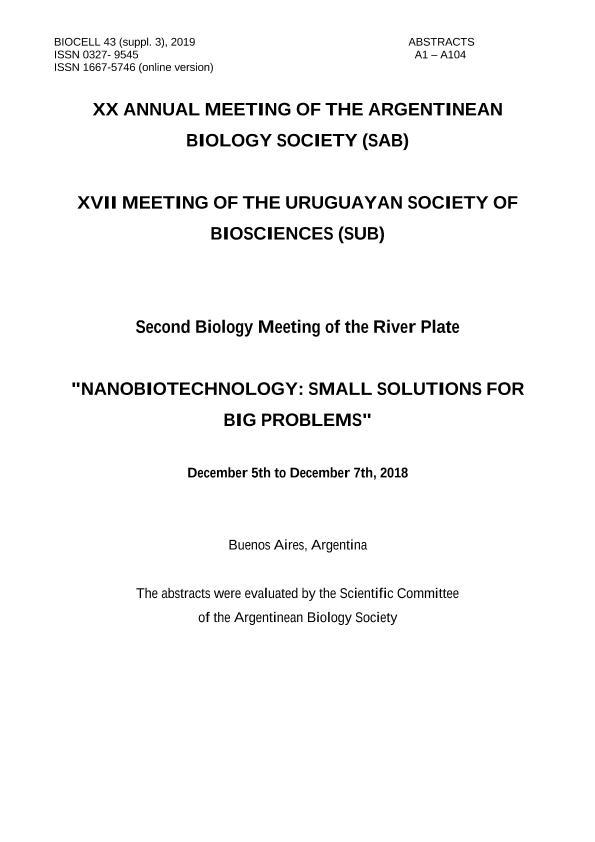Evento
Effects of carbon sources on secondary metabolites biosynthesis by Fusarium verticillioides
Achimón, Fernanda ; Jacquat, Andrés Gustavo
; Jacquat, Andrés Gustavo ; Brito, Vanessa Daniela
; Brito, Vanessa Daniela ; Dambolena, José Sebastián
; Dambolena, José Sebastián ; Zygadlo, Julio Alberto
; Zygadlo, Julio Alberto ; Pizzolitto, Romina Paola
; Pizzolitto, Romina Paola
 ; Jacquat, Andrés Gustavo
; Jacquat, Andrés Gustavo ; Brito, Vanessa Daniela
; Brito, Vanessa Daniela ; Dambolena, José Sebastián
; Dambolena, José Sebastián ; Zygadlo, Julio Alberto
; Zygadlo, Julio Alberto ; Pizzolitto, Romina Paola
; Pizzolitto, Romina Paola
Tipo del evento:
Reunión
Nombre del evento:
XX Annual Meeting of the Argentinean Biology Society and XVII Meeting of the Uruguayan Society of Biociences
Fecha del evento:
05/12/2018
Institución Organizadora:
Sociedad Argentina de Biología;
Título de la revista:
Biocell
Editorial:
Tech Science Press
ISSN:
0327-9545
Idioma:
Inglés
Clasificación temática:
Resumen
Fusarium verticillioides is one of the most important fungal pathogens of maize, being responsible of major economic losses worldwide due to its effect on grain quality and mycotoxincontamination, particularly fumonisin B1 (FB1), which is extremely harmful to human and animal health. Secondary metabolites (SMs) production often occurs during stationary phase.F. verticillioides SMsinclude toxins such as FB1, volatile organic compounds such assesquiterpenes (SQT) and pigments (naphthoquinones), among other metabolites. The aim of the present study was to determine the effect of different carbon sources, consisting of glucose, sucrose, lactose, fructose or xylose, on vegetative growth and secondary metabolism in F. verticillioides. For evaluation of growth, F. verticillioides M3125 was incubated at 28°C in Czapek Dox Agar (CDA)supplemented with different carbon sources. For evaluation of secondary metabolites, liquid GYAM medium was used (adjusted to pH 3) andcultureswere incubatedwith shaking at 25°C for 7 days. At the end of the incubation period, pHvalue was registered, FB1 quantification was performed using a HPLC, SQT quantification was carried out using a GC-MS and total naphthoquinones were quantified with a spectrophotometer. Lower lag phase values were achieved with lactose and sucrose as carbon sources (both disaccharides), compared to glucose, xylose and fructose (monosaccharides). This may be explained by the development of more extended andpoor branched hyphae when the fungus grows with disaccharides as carbon sources. This may be a strategyto explore the surrounding media for areaswith simpler carbohydrates. The growth rate was higher with fructose and conidiation was higher with lactose. FB1 biosynthesis was statistically higher with sucrose and glucose (both with pH 3.5) and lower with xyloseand fructose. On the other hand, naphthoquinone biosynthesis was statistically higher with fructose (pH 3.7) followed by xylose (pH 4.8),while lower values were achieved with glucose and sucrose. Lactose did not support the biosynthesis of these SMs.On the other hand, SQT biosynthesis was statistically higher with xylose compared to the other carbon sources.According to our results, growing parameters, conidiation and biosynthesis of secondary metabolites are regulated by both environmental (pH) and nutritional factors (carbon source).Also, our results suggest an inverse relationship between FB1 and naphthoquinones biosynthesis. It is well documented that both metabolites proceed via the polyketide route by formation of a common precursor. In addition, there are global and specific regulators that respond to environmental signals and activate one of the metabolites while repressing the other. SQT productiondoes not show apattern with the other SMs studied. In fact, its biosynthesis proceeds through a different pathway, the mevalonic acid pathway. It has been proposed that trichodiene synthase activity is optimum at pH values near 6, which could explained the higher amount of SQT produced with xylose as carbon source (pH 4.8). However, xylose itself could represent a signal that inducesSQT biosynthesis.
Palabras clave:
SECUNDARY METABOLITES
,
FUSARIUM VERTICILLIOIDES
,
CARBON SUORCES
Archivos asociados
Licencia
Identificadores
Colecciones
Eventos(IMBIV)
Eventos de INST.MULTIDISCIPL.DE BIOLOGIA VEGETAL (P)
Eventos de INST.MULTIDISCIPL.DE BIOLOGIA VEGETAL (P)
Citación
Effects of carbon sources on secondary metabolites biosynthesis by Fusarium verticillioides; XX Annual Meeting of the Argentinean Biology Society and XVII Meeting of the Uruguayan Society of Biociences; Buenos Aires; Argentina; 2018; 1-2
Compartir



